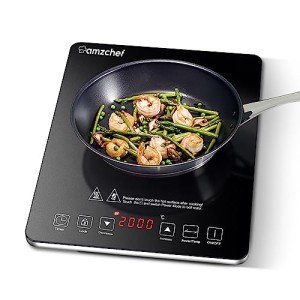10 Tips To Build Your Induction Hob Troubleshooting Empire
Induction Hob FAQ: Everything You Need to Know
Induction cooking has gotten considerable popularity over recent years, declared for its efficiency, speed, and safety features. More homeowners are making the switch from traditional gas or electric stoves to induction hobs, due in part to their modern style and innovative technology. Nevertheless, with this growing pattern comes a lot of concerns. Ovens And Hobs intends to resolve some of the most often asked concerns worrying induction hobs, to assist consumers make informed choices.
What is an Induction Hob?
An induction hob is a cooking device that uses electro-magnetic fields to straight heat pots and pans, rather than heating up the surface of the cooktop itself. This indicates that only the pots and pans gets hot, while the cooktop stays cool to the touch. Induction hobs are not just energy-efficient however likewise offer precise temperature control, making them a preferred choice for many cooks.
Benefits of Induction Cooking
- Energy Efficiency: Induction hobs utilize around 90% of the energy produced, compared to about 70% for gas.
- Quick Cooking: Induction cooking is quicker than standard methods, with water boiling in just a few minutes.
- Safety: Since the cooktop stays cool and only warms the pan, the risk of burns is decreased.
- Easy to Clean: With a flat surface area that doesn't get hot, spills can be wiped up quickly.
Induction Hob FAQs
1. How Does Induction Cooking Work?
Induction cooking operates through the principle of electromagnetic induction. When an induction pot is placed on the hob and turned on, a rotating existing develops a magnetic field that creates heat directly within the cookware.
2. What Types of Cookware Are Compatible?
Induction cooking requires magnetic pots and pans. Here is a list of compatible products:
- Cast Iron: Excellent heat retention.
- Magnetic Stainless Steel: Good for daily cooking.
- Enamel-Coated Cookware: Often made from cast iron and appropriate for induction.
- Some Copper Cookware: If it has a magnetic base.
3. Are Induction Hobs Safe?
Yes, induction hobs are considered extremely safe. They will not spark like gas, and the surface area cools quickly after usage. The hob will only trigger when compatible pots and pans is put on it, preventing unintentional burning or ignition.
4. How Do I Clean My Induction Hob?
Cleaning up an induction hob is easy, thanks to its smooth surface. Here are some actions to keep it beautiful:
- Immediately Wipe Spills: Use a damp fabric while the surface is still warm however not hot.
- Utilize a Hob Cleaner: For tougher spots, use a specialized cleaner and a non-abrasive sponge.
- Avoid Abrasive Materials: These can scratch the surface.
5. Can I Use Traditional Pans on an Induction Hob?
Standard pans made from non-magnetic products like glass, aluminum, or ceramic will not work on an induction hob unless they have a magnetic base. It's a good idea to look for an induction-compatible symbol on their bases.
6. Are Induction Hobs More Expensive?
While induction hobs can be more pricey than traditional electric or gas stoves, they might save you money in the long run due to their energy performance and decreased cooking times.
7. Do Induction Hobs Produce Heat in the Kitchen?
Induction hobs produce very little heat in the kitchen compared to gas or electrical ranges since only the pot or pan is warmed. This can create a more comfy cooking environment, particularly in warm weather condition.
8. How Do I Know if My Cookware is Induction-Compatible?
To check whether your pots and pans is induction-compatible, use a magnet. If the magnet adheres to the pot's base, it is appropriate for an induction hob. If it doesn't, it will not work successfully on an induction surface.
9. What Happens if I Use the Wrong Cookware?
Using incompatible cookware will cause poor heating and ineffective cooking. The induction hob will not activate, or it might take substantially longer to heat the food, resulting in an aggravating cooking experience.
10. Can Induction Hobs be Installed Anywhere?
Yes, induction hobs can generally be installed in the majority of kitchen areas, provided there suffices ventilation and power supply. Nevertheless, check particular installation requirements and regional building regulations.
Advantages and disadvantages of Induction Hobs
Pros
Advantages
Description
Speed and Efficiency
Cook meals much faster and with less energy compared to conventional methods.
Safety
Reduces burn risks and has automated shut-off features.
Precise Control
Enable precise temperature level adjustments and immediate modifications when required.
Easy to Clean
Smooth surface area permits uncomplicated cleaning.
Cons
Downsides
Description
Pots and pans Compatibility
Needs particular magnetic cookware.
Initial Cost
Typically more pricey than traditional ranges.
Sound
Some induction hobs can make sounds when in usage due to fan or magnetic vibrations.
Limited Power Supply
May require an electrical upgrade for appropriate installation.
Induction hobs represent a modern cooking solution that integrates efficiency with security and ease of usage. By understanding how induction cooking works and resolving typical user inquiries, prospective buyers can make informed choices tailored to their kitchen area needs. Transitioning to an induction cooking system can transform culinary practices and improve general kitchen area experiences.
Frequently asked questions Recap
What pots and pans works?
- Magnetic products like steel and cast iron.
Are induction hobs safe?
- Yes, they are extremely safe due to the minimal surface heat.
Do they require special cleansing?
- No, they can be cleaned up quickly with standard items.
What are the energy cost savings?
- Induction hobs utilize around 90% of energy utilized.
Are they worth the investment?
- Yes, they can minimize energy costs and offer quicker cooking times.
By addressing regularly asked questions about induction hobs and providing a comprehensive comparison of their advantages and disadvantages, customers can feel equipped to decide about this innovative cooking technology.
